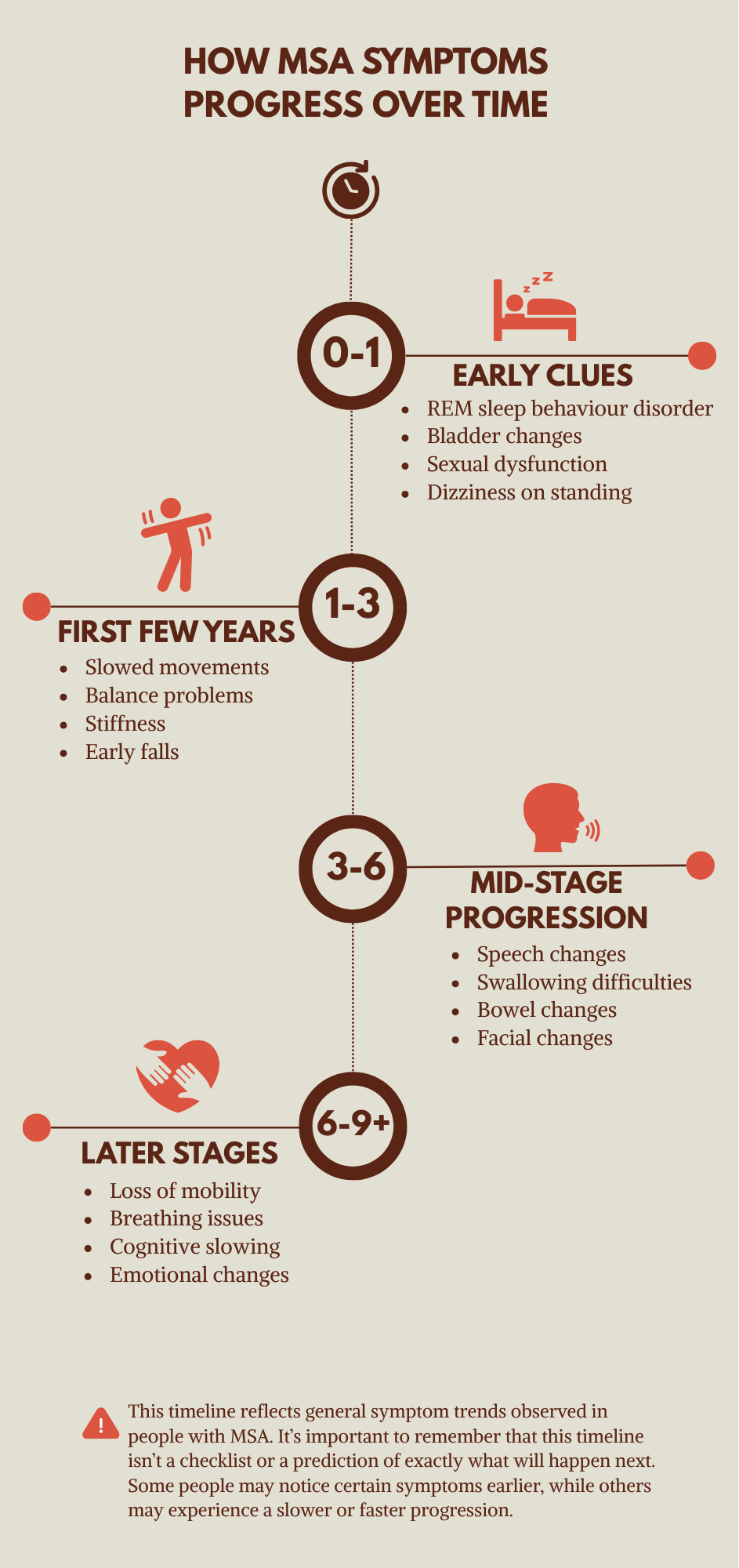Early Symptoms of MSA
When we talk about “early symptoms” in Multiple System Atrophy, it’s important to know there isn’t one single starting point. MSA can first show itself in different ways, depending on which system in the body is affected earliest. For one person, it may begin with sleep changes. For another, bladder problems. For others, it might look like Parkinson’s disease. MSA has different “entry points” into the same illness and recognising these patterns matters, because the earlier MSA is considered as a possibility, the sooner care and support can be tailored.
The list of symptoms below is based on what’s most commonly reported in medical research and from patient experiences. Not everyone will notice the same early signs, and symptoms may appear in a different order. This guide is here to help you recognise the possible patterns of onset, not to serve as a checklist for diagnosis. If you or someone you care about is experiencing these symptoms, it’s always best to speak with a medical professional for tailored advice.
Sleep cues
🚩One of the most striking early signs is REM Sleep Behaviour Disorder (RBD), where the body doesn’t switch off muscle activity during dreams. People may shout, punch, or kick in their sleep. This can appear years before other symptoms, making it one of the strongest early red flags.
Autonomic cues (automatic functions)
MSA often begins with changes in the body’s automatic systems:
🚩Bladder problems such as urgency, frequency, or incomplete emptying.
🚩Erectile dysfunction in men or reduced physical sensation in women.
🚩Dizziness or fainting when standing up due to a drop in blood pressure (orthostatic hypotension).
Sometimes these issues appear years before movement changes, which is why doctors take them seriously as potential early markers.
Movement and balance cues
For many people, MSA first looks like a movement disorder.
🚩Slowed movements or stiffness, often mistaken for Parkinson’s disease.
🚩Unsteadiness or stumbling, especially on uneven ground.
🚩Early falls - about 1 in 5 people with MSA experience a fall in the first year after onset.
These motor changes can be subtle at first but usually progress faster than Parkinson’s disease and may not respond well to Parkinson’s medications.
Why this matters
On their own, many of these symptoms could be caused by other, more common conditions. What makes MSA different is when several of these changes appear together - for example, sleep disturbances alongside bladder issues, or balance problems plus early falls. Seeing the cluster is what gives doctors a clearer picture and helps families make sense of what’s happening.
Understanding these patterns provides a narrative for what might otherwise feel like a confusing mix of unrelated problems. Recognising the bigger story can help you raise the right questions with your doctor and start planning the support you need sooner.
Symptoms by MSA-type
Although Multiple System Atrophy is one disease, it often begins in one of two ways. Doctors call these types MSA-P (Parkinsonian) and MSA-C (Cerebellar). The main difference is where the earliest changes show up in the brain, which shapes the first part of the journey. Over time, the two types overlap, and most people experience symptoms from both groups.
MSA-P: Parkinsonian
How it starts: The first signs often resemble Parkinson’s disease - slowed movements, stiffness, and sometimes tremors. People may notice their walk becoming shuffling or that fine tasks (like doing up buttons) are harder.
Key differences from Parkinson’s:
🚩Symptoms tend to progress more quickly.
🚩Medications like levodopa that usually help in Parkinson’s often work poorly or wear off quickly in MSA-P.
Early impact: This type is the most common in Australia, and many people are initially told they have Parkinson’s until other clues (like blood pressure drops, bladder changes, or faster progression) emerge.
MSA-C: Cerebellar
How it starts: The earliest symptoms affect balance and coordination. Walking may feel unsteady, veering to one side, or stumbling more often. Speech may become slightly slurred, and swallowing can be difficult earlier than expected.
Key differences from other ataxias:
🚩The unsteadiness progresses faster than in many inherited ataxias.
🚩Autonomic symptoms (like bladder problems and dizziness on standing) tend to appear sooner than in pure ataxia disorders.
Early impact: Day-to-day life can be affected by falls, difficulties with clear speech, or fatigue from trying to stay upright.
Why this matters
Hearing that MSA can be “Parkinsonian” or “Cerebellar” can feel confusing, as though there are two different diseases. In reality, they’re simply different starting points on the same journey. Over time, most people experience a blend of both sets of symptoms. Knowing which type you began with helps explain the first changes you noticed, but it doesn’t change the fact that you and others are living with the same condition. This perspective can provide reassurance - your story fits within the broader MSA community, no matter which path you started on.

PROGRESSION
MSA is a progressive condition, which means symptoms build up and change over time. At first, the illness may look like something more familiar - such as Parkinson’s disease or a balance disorder - but as the years go on, the differences become clearer.
Not everyone experiences the same journey, and there’s no exact calendar that says when symptoms will appear. What researchers and families often see, though, is a pattern:
-
Early clues (0-1 years): Subtle changes such as sleep disturbance, bladder problems, or dizziness when standing.
-
First few years (1-3 years): Movement and balance issues emerge - slowed movements, stiffness, unsteadiness, and sometimes early falls.
-
Mid-stage progression (3-6 years): Speech may become quieter or slurred, swallowing can feel difficult, constipation becomes more common, and facial expressions may appear reduced.
-
Later stages (6-9+ years): Mobility decreases, breathing difficulties and emotional changes become more noticeable, and support from specialists becomes essential.
Why this matters
Progression doesn’t mean one symptom disappears and another replaces it - symptoms layer on top of each other. It’s the clustering and overlapping that define the journey. Knowing the general rhythm of MSA progression can help families plan ahead, organise care, and make sense of what might otherwise feel like a random series of changes.
late stage msa
Trigger Warning: The following content discusses advanced symptoms and end-of-life considerations. Please read at your own pace.
What to expect
In the later stages of MSA, the condition becomes more physically demanding. Most people lose the ability to walk, talk, and swallow without assistance. Full-time support is often required, and care may take place at home, in a residential facility, or within a palliative care setting.
While every person’s experience is different, the final stage may involve:
-
Severe movement loss: usually requiring a wheelchair or bed-based care
-
Swallowing difficulties: often making eating and drinking unsafe without support or intervention
-
Speech loss or very limited communication: though many people remain mentally aware and engaged internally
-
Bladder and bowel incontinence
-
Increased risk of respiratory infections, particularly due to aspiration (food or saliva entering the lungs)
-
Cognitive changes: such as slowed thinking, difficulty responding, or reduced memory function (though not always)
The focus in this stage shifts to comfort, dignity, and maintaining connection. Many families explore palliative care services to support both the person living with MSA and those around them. This may include pain management, emotional support, and decision-making around medical interventions.
It’s important to know that even in this stage, people with MSA often remain aware of their surroundings and relationships, even if they can no longer express it in familiar ways. Respect, gentleness, and presence still matter deeply.
Disclaimer
The information on this website is provided for general awareness and educational purposes only. It is not intended to be a substitute for professional medical advice, diagnosis, or treatment. Always seek the guidance of your doctor or other qualified health professional with any questions you may have regarding a medical condition. Never disregard professional medical advice or delay in seeking it because of something you have read on this site.



